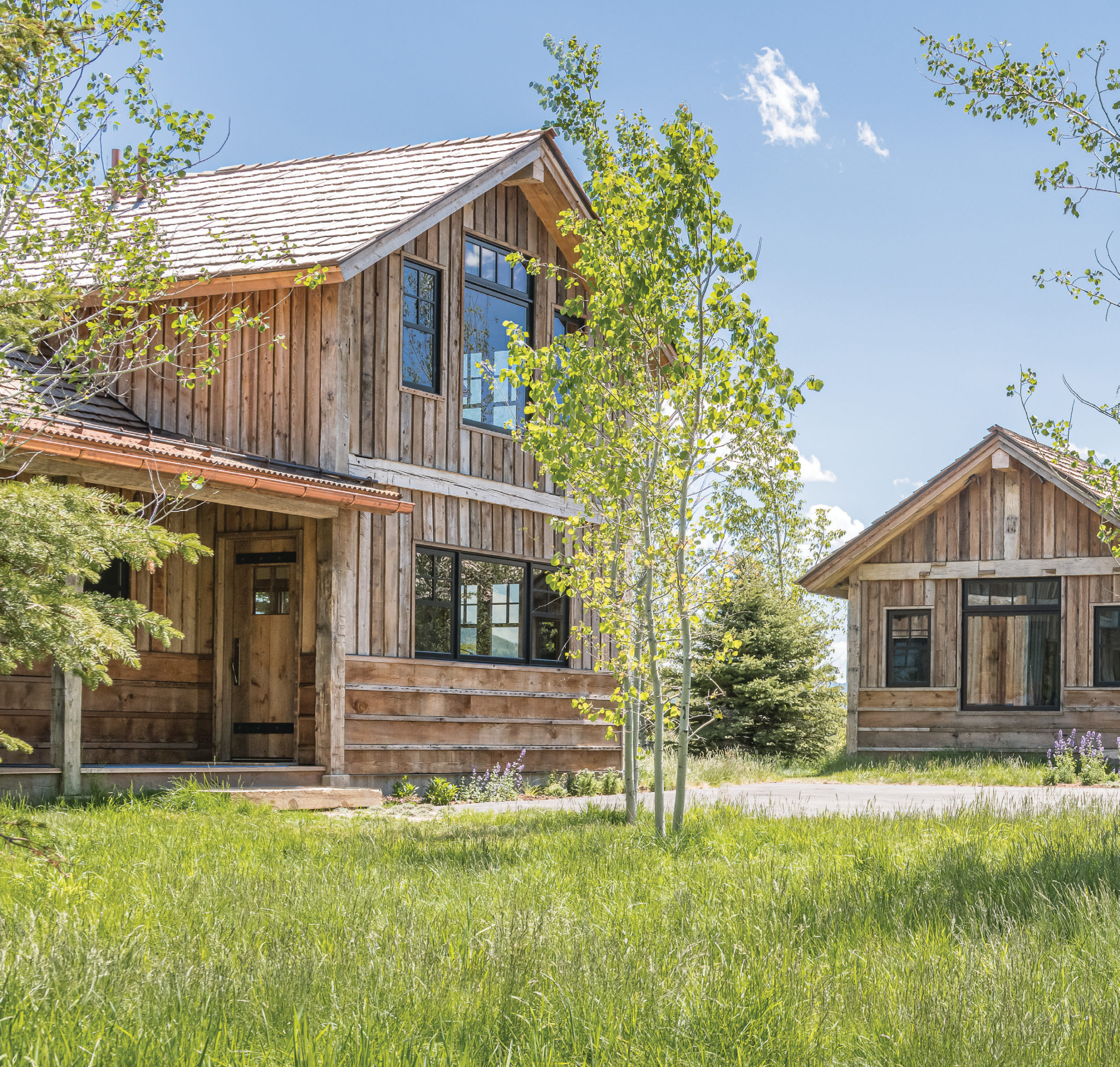
07 Apr Balancing Act
IT’S ONE THING TO CREATE A COMPOUND ON THE SPRAWLING acreage of a ranch. But it’s quite another to create a compound-like setting on a site that sits at the edge of a golf course. However, says John Lauman, of JLF Architects, in this case, his clients were specifically not interested in a starter castle. Rather, they were seeking a more modestly scaled presence for what was to be their full-time home. They would use a layout of buildings to create a sense of arrival, screen out neighbors, and direct one’s gaze to the primary southern views over open space toward the Teton Mountains. And the multiple structures, mostly attached, would create privacy and a sense of remoteness.
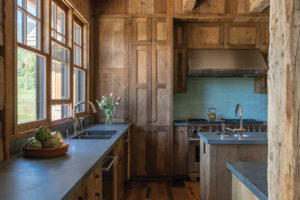
A home and guest house in Jackson Hole, Wyoming, designed by JLF Architects and built by Big-D Signature, uses reclaimed materials to establish a sense of place. In the kitchen, the Shaker-inspired fir cabinets and glazed fireclay tile backsplash convey serenity
The homeowners, recently retired and active outdoors people with grown children, had decided to relocate to Jackson Hole, Wyoming, from the East Coast, when they chose their site and retained JLF to design their home. Enthusiastically involved from the beginning, they rented a house nearby to live in while the construction took place.
Originally conceived as a U-shaped structure with a parking courtyard, big views over the open landscape to the south, and a guest cabin connected by a covered walkway, the design expanded and evolved over the course of the project. The intended guesthouse became the husband’s office and retreat, and the guest quarters moved across the driveway to the corner of the property. Meanwhile, the covered walkway became a glassy connector to offer shelter from the elements and a major “Aha!” moment as one glimpses the mountain views en route.
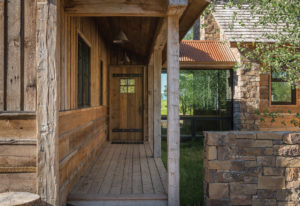
A separate entrance leads from the parking court to the husband’s retreat, which is connected to the main home by a glassy hallway with views of the Teton Mountains.
The arrival sequence leads guests to the front door, which is located under a gabled porch in the center of the main mass of the reclaimed-timber and cedar-shake-roofed house. A low stone wall creates a division between the structure and the driveway, and a barn-like garage wing sits off to the right. To the left, the attached log cabin retreat has its own entry, and a glass-walled, metal-roofed connector links it to the main house and lightens the mass by offering transparency and views to the mountains.
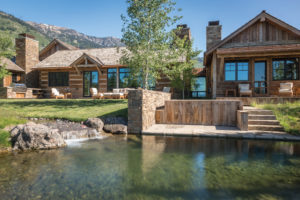
The house makes the most of its position on the edge of a development by facing the expansive mountain views, and it connects to a shallow pond that can be accessed from both the private porch of the husband’s getaway and the living room of the main house.
At the entrance, the simple stone-floored foyer reveals stacked log corners in a nod to the origin of the reclaimed materials. Despite the “announcement of place” that happens as the gaze travels straight through the living room to the long prospect south, dramatic scissor trusses made of heavily distressed reclaimed materials dominate the space and draw the eye upward.
“We find that a truss is nice in dividing a volume,” explains Lauman. “Historically, a truss is a horizontal bottom cord; this was mostly out of necessity and ease of construction. But a bottom cord is sometimes too close to the human scale.” In this case, the truss generates energy and celebrates the room’s sense of space. The structure also creates a powerful architectural moment within the vaulted-ceilinged space and acts as a counterpoint to the weight of the expansive view.
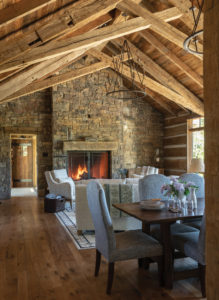
The living room is the heart of the home. Scissor trusses of distressed reclaimed timbers create drama. Interiors by Jet Zarkadas, of Los Griegos Studio, include a custom hide rug in a stylized pattern inspired by Navajo designs.
The bedrooms radiate out from the living, dining, and kitchen area, some in a second level over the garage, and the master suite juts out to the south toward the open landscape. This is mirrored by the husband’s retreat, constructed as if it were a separate cabin with a heavy, lodge-like ambience. The simple gabled form is oriented away from the house toward the view, with its own shed-roofed porch that overlooks a hot tub and pond. Verdone Landscape Architects was tasked with creating the water feature, and its cascades provide a soothing trickling sound, while the pond, depending on the season, creates the effect of a winter wonderland or summertime idyll.
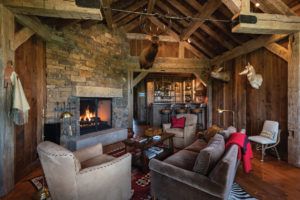
The masculine retreat is a departure from the clean, more contemporary lines of the main house. The cozy, cave-like space, centered on its stone fireplace, features animal mounts and a full bar
Interior designer Jet Zarkadas, of the Santa Fe-based Los Griegos Studio, helped the owners balance the masculine and feminine, the heavily rustic with the more refined, and the family’s East Coast past with its New West present. She assisted the husband in creating his retreat, which features an elaborate bar, cigar smoking accoutrements, and animal mounts.
With the wife, Zarkadas scoured the family’s existing collection of furniture to select pieces that could transition to mountain living. A statement rug crafted from hides in a stylized Navajo pattern grounds the living room and serves as the base upon which the rest of the space takes its cues.
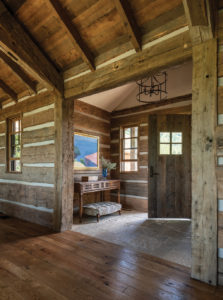
The foyer feels like a log cabin, with stacked-log corners. The chandelier is by Jeff Morris, and the entry table and low bench were designed by Los Griegos Studio and made by Hands of America in Santa Fe, New Mexico.
Zarkadas says the water-referencing tones found throughout the house speak to the owners’ longtime passion for the Turks and Caicos Islands, as well as their previous coastal home. The kitchen is a study in serenity with Shaker-inspired frame-and-panel reclaimed fir cabinets, greenish-gray Pietra Cardosa countertops, oak floors, and a glazed clay tile backsplash in a tranquil pale aqua. The bedrooms and guesthouse feature sophisticated simplicity and comfort. The goal, says the designer, was “a refined mountain elegance.”
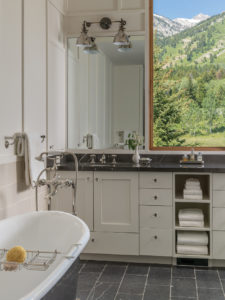
In the light-filled master bath, with a freestanding tub and black-and-white color scheme, mountain views take pride of place.
The home succeeds in balancing its different personas by establishing a strong sense of place through its materiality and authenticity. “We strive for truth in materials,” explains Lauman. “If there’s log, it needs corners. If there’s stone veneer, the wall needs to be thick enough that it could be a stone wall.” In the log cabin-like wing, the windows are historically appropriate, double hung rather than casement. To that end, new oak floors were treated for an aged look, while walls, beams, and kitchen cabinets were made from reclaimed wood.
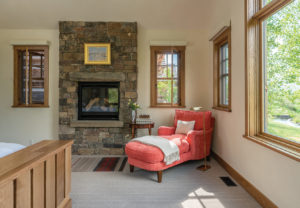
A separate guest house, across the driveway from the main house, completes the compound. In the bedroom, simple wood-trimmed windows, a gas fireplace, and pops of color tie the room together.
Having master craftsmen — such as those with Big-D Signature (JLF’s construction partner) — executing the details accentuates this project, as does the sense of place conveyed by the work of Wyoming blacksmith Jeff Morris, who created much of the hardware, light fixtures, chandeliers, and fireplace doors. The solidity and tactile nature of hand-forged metal and antique materials imbues the home with a palpable regional authenticity and helps this cabin-like compound celebrate its spectacular Wyoming setting.




No Comments